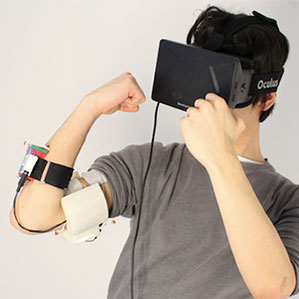Get a Virtual-Reality Punch, Feel Real Impact
Imagine playing a virtual-reality boxing game, complete with a menacing opponent aiming a haymaker at your head. You get your gloves up in time to block the punch, but you feel no impact when it hits, breaking the otherwise immersive experience.

Impacto, a prototype developed by researchers in the Human-Computer Interaction (HCI) lab at the Hasso Plattner Institute in Germany, sidesteps this deficit in mainstream VR experiences. The technology consists of an armband that combines basic haptic feedback (a tap or vibration on the skin) with electrical muscle stimulation to push or pull the user’s limb in a way that convincingly simulates a physical impact.
“It’s kind of an illusion,” says Patrick Baudisch, who leads the HCI lab. “We want the user wearing a VR headset to believe that he was really hit by something.”
Led by Pedro Lopes, the team simulated this physical force by re-creating the effect it would naturally have on the user’s body. They began with a VR boxing game using an Oculus Rift headset. To create the sensation of an opponent’s punch “landing,” the team developed a small armband that delivers a physical tap to the wearer’s skin at the point of virtual impact. A pair of electrodes stimulates the wearer’s biceps muscle to contract at the same time.
The result? “You see your opponent land a punch, you feel something on your skin, and your arm flies backwards,” Baudisch says. All that gives the sensation of being hit. Impacto can also be combined with props to create convincing experiences of hitting a virtual baseball or bouncing a virtual soccer ball on one’s foot—anything that involves a classic Newtonian “equal and opposite reaction.” Currently the illusion is only convincing for “impacts” of 200 milliseconds or less, but the team is already investigating how to extend the concept to create continuous impulses that extend over time (for example, driving a car along a guardrail in a virtual racing game).
Unlike the Oculus Rift, Impacto is just a proof of concept designed to show that small haptic interfaces, working in concert, can create seamless immersive experiences that currently require bulky and expensive technology. “Traditional ways of actuating muscles [in haptic interfaces] use motors and batteries, but that doesn’t scale very well,” Baudisch explains. “If you want to convey a virtual experience that affects the whole body, perhaps with a large force, you’ll quickly find yourself in a ‘Sigourney Weaver in Aliens’ situation where the person is buried in a giant exoskeleton. The idea behind Impacto is you already have a skeleton—let’s just use that one.”
Baudisch sees Impacto as a prototype for future gaming or telepresence interfaces–a “vision for post-wearable technology,” he says. As headsets like Google Cardboard make the visual aspect of VR cheaper and more ubiquitous, additional sensory dimensions must follow suit in order to support fully immersive experiences (see “Google Aims to Make VR Hardware Irrelevant Before It Even Gets Going”).
According to Sean Whitmore, an analyst at Greenlight VR, a research and consulting firm specializing in the virtual-reality industry, “mastering the fundamental audiovisual relationship with the user” is more important for developers right now than adding haptic and force-feedback interfaces, which may not find mainstream application until 2020 or later. Still, “the approach of combining different sensory stimuli [within virtual reality] to produce specific effects is exciting,” says Judy Vance, a professor of mechanical engineering who studies haptic interfaces at Iowa State University’s Virtual Reality Applications Center. “Fred Brooks once wrote that virtual reality will have arrived when you can walk down the aisle of a virtual airplane and stub your toe on the seat. This technology would do that.”
Keep Reading
Most Popular
Large language models can do jaw-dropping things. But nobody knows exactly why.
And that's a problem. Figuring it out is one of the biggest scientific puzzles of our time and a crucial step towards controlling more powerful future models.
The problem with plug-in hybrids? Their drivers.
Plug-in hybrids are often sold as a transition to EVs, but new data from Europe shows we’re still underestimating the emissions they produce.
Google DeepMind’s new generative model makes Super Mario–like games from scratch
Genie learns how to control games by watching hours and hours of video. It could help train next-gen robots too.
How scientists traced a mysterious covid case back to six toilets
When wastewater surveillance turns into a hunt for a single infected individual, the ethics get tricky.
Stay connected
Get the latest updates from
MIT Technology Review
Discover special offers, top stories, upcoming events, and more.